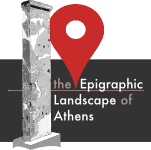Description
Date
44-43 BCE
Period: 1st century BCE --> second half
Reasons: historical context, prosopography
See notesThe base should be dated to the period of Brutus' visit to Athens in the second half of 44 BCE or shortly after that period. He stopped off in the city on his way to Asia and waiting to take over his proconsulship in Crete in January 43 BCE.
The lettering of the text seems also to point to the mid-1st cent. BCE.
Text category
honorific dedication (tabula honoraria)
See notesDedication by the Demos to the Caesaricide Brutus.
He is remembered here by his adoptive name, Q. Servilius Q. f. Caepio Brutus (DNP 11, s.v. ‘Servilius’ I 15«Der Neue Pauly. Enzyklopädie der Antike», Stuttgart = DNP 6, s.v. 'Iunius' I 10«Der Neue Pauly. Enzyklopädie der Antike», Stuttgart), that he acquired in 59 when he was officially adopted by a Q. Servilius Caepio, a relative (perhaps a brother) of his mother Servilia; he is in fact named Q. Caepio Brutus also by Cicero (Cic. Phil. 10, 25-26M. Tullius Cicero), Appian (App. BC 2, 111, 464Appianus: erroneously Marcus Brutus Caepio), Dio Cassius (Dio Cass. 41, 63, 6Dio Cassius, «Rhomaike Historia»: again Marcus Brutus Caepio) and in a dedication to Amphiaraos at Oropos (IG 7 383), while at Delos he was honoured by the Athenians and the locals only by the name Caepio (ID 1622Inscriptions de Délos, voll. I-VII, Paris 1926-1972).
We know that after Caesar's murder Brutus was welcomed in Athens with enthusiasm and received not only public eulogies and honorific decrees (Plu. Brut. 24, 1Plutarchus), but also a bronze statue together with Cassius in a prominent place of the "asty" (Dio Cass. 47, 20, 4Dio Cassius, «Rhomaike Historia» = Ath.Agora 3 95 and 208 no. 262Wycherley R., «The Athenian Agora III. Literary and Epigraphical Testimonia», Princeton 1957; cf. ELA id: 410); cf. Payne 1984 317-318 no. I.211M.J. Payne, «Aretas eneken: Honors to Romans and Italians in Greece from 260 to 27 B.C.», (PhD Diss., Michigan State University), Ann Arbor 1984. At Delos he also received a statue for his acts of benevolence towards the Athenians (ID 1622Inscriptions de Délos, voll. I-VII, Paris 1926-1972; cf. Habicht 1995 (2 éd., 2006) 501 note 90Habicht Ch., «Athènes hellénistique. Histoire de la cité d'Alexandre le Grand à Marc Antoine», 2 éd. revue et augmentée, Paris 2006).
On his adoption and name cf. Raubitschek 1959 17-21Raubitschek A. E.,«The Brutus Statue in Athens», in « Atti del III Congresso Internazionale di Epigrafia Greca e Latina (Roma, 4-8 settembre 1957», Roma 1959, 15-21 + tavv. III-VII, while on the relationships between Brutus and Athens see also Habicht 1995 (2 éd., 2006) 391-393Habicht Ch., «Athènes hellénistique. Histoire de la cité d'Alexandre le Grand à Marc Antoine», 2 éd. revue et augmentée, Paris 2006.
Monument description
Monument type: base
Material: Hymettian marble
Letters Height Mt: ca. 0.042
This base has been identified by the first and only editor - Raubitschek - with one of those supporting the well-known bronze statues set up in honour of the two Caesaricides, Brutus and Cassius, and mentioned by Dio Cassius (Dio Cass. 47, 20, 4Dio Cassius, «Rhomaike Historia»). The historian reports that the two images were placed by the statues of Harmodios and Aristogeiton, but Raubitschek 1959 21Raubitschek A. E.,«The Brutus Statue in Athens», in « Atti del III Congresso Internazionale di Epigrafia Greca e Latina (Roma, 4-8 settembre 1957», Roma 1959, 15-21 + tavv. III-VII points out that at that time in the Agora there were two different pairs of statues portaiting Hipparchos' slayers, an older one by Antenor and one restored by Kritios and Nesiotes (cf. Paus. 1, 8, 5Pausanias, «Hellados Periegesis») and assumes that in order to honour Brutus and Cassius the Athenians may have only reinscribed the bases of one of the two groups portaiting Harmodios and Aristogeiton.
For the parallel statue for Cassius cf. ELA id: 410 (testimonium).
Physical features
Measurements: h: 0.35 * w: 0.51 * t: ca. 0.21
State of conservation: Top, bottom and right side preserved
Legibility: Good. Two lines of text (right portion), ll. 2-3
Reuse: Perhaps reused "in situ" at the time of Brutus, certainly reused and moved in modern times
See notesPhoto in Raubitschek 1959 tav. IIIRaubitschek A. E.,«The Brutus Statue in Athens», in « Atti del III Congresso Internazionale di Epigrafia Greca e Latina (Roma, 4-8 settembre 1957», Roma 1959, 15-21 + tavv. III-VII
Findspot
Found in modern context over the Panathenaic Way outside the Agora to the southeast
Date of discovery: 1936
Circumstances: archeological excavation
Raubitschek 1959 18Raubitschek A. E.,«The Brutus Statue in Athens», in « Atti del III Congresso Internazionale di Epigrafia Greca e Latina (Roma, 4-8 settembre 1957», Roma 1959, 15-21 + tavv. III-VII = SEG 17, 75Supplementum Epigraphicum Graecum
Original location
The location of the statues of Brutus and Cassius is closely related to that of the statuary groups of Harmodios and Aristogeiton, by which the images of the Caesaricides were set up making an exception to the traditional prohibition to erect monuments around the Tyrannicides. Although still controversial, it seems that the two groups of Tyrannicides stood by the Orchestra in the Northern sector of the Agora, where we should also place our base. In Roman times the statue of Harmodios and Aristogeiton stood probably between the temple of Ares and the Odeion, but since the statuary groups were actually two and the position of the Orchestra and the statues has not been ascertained yet, we cannot point to a more precise spot than the central or northern area of the Square. In any case, the reuse of our base outside the Agora to the southeast is not of help for the identification of the original location of those monuments.
Therefore, tag "uncertain" refers here not the proximity of the statue to the Groups of the Tyrannicides but to the location of such groups in the Agora, erected in the central or northern part of the Agora ("Northern sector"?).
✓uncertain
See notesCf. Habicht 1995 (2 éd., 2006) 349Habicht Ch., «Athènes hellénistique. Histoire de la cité d'Alexandre le Grand à Marc Antoine», 2 éd. revue et augmentée, Paris 2006; Krumeich - Witschel 2009 208-209 and fn. 142Krumeich R., Witschel Ch.,«Hellenistiche Statuen in ihrem räumlichen Kontext: Das Beispiel der Akropolis und der Agora von Athen», in A. Matthaei, M. Zimmermann (hrsg.), « Stadtbilder im Hellenismus», Berlin 2009, 173-226.
On the statues of Harmodios and Aristogeiton and their location cf. Ath.Agora 14 155-158 and pl. 8Thompson H. A. - Wycherley R. E., «The Athenian Agora XIV. The Agora of Athens: the History, Shape and Uses of an Ancient City Center», Princeton 1972; Camp 2010 104-105Camp II J.McK., «The Athenian Agora: Site Guide», Athens 2010.;
Ma 2013 104, 118J. Ma, «Statues and Cities. Honorific Portraits and Civic Identity in the Hellenistic World», Oxford 2013;
Topografia di Atene, 3** 1077-1079E. Greco (a cura di), «Topografia di Atene. Sviluppo urbano e monumenti dalle origini al III sec. a.C.», Tomo 3**: «Agora del Ceramico», Atene-Paestum 2014 (Di Cesare)


